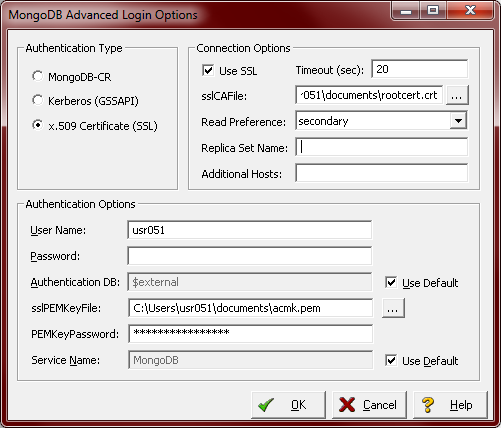MongoDB Advanced Login Options
Go Up to Reverse Engineering an Existing Database
Contents
On page one of the reverse engineer wizard, if you select the Database Type of MongoDB you will have the an Advanced Options button appear. Clicking it brings up the following options.
Authentication
MongoDB-CR
Select this option to use regular MongoDB authentication. Users can specify a user name and password to authenticate against a database on the server. The authentication database is 'admin' by default when using this authentication type, but can be changed to another database by unchecking the Use Default checkbox next to the Authentication DB control. If no user name is provided, then a connection is attempted without authentication.
Kerberos (GSSAPI)
Select this option to authenticate with Kerberos authentication. Users can specify the user name and password, and optionally provide a GSSAPI service name.
x.509 Certificate (SSL)
This option allows users to authenticate via x.509 certificate. A user name, PEM key file and optional PEM key password can be provided. Authenticating via x.509 certificate requires an SSL connection.
Connection Options
Use SSL
Users may choose encrypt the connection to MongoDB with SSL by checking the Use SSL option. Users may also provide a path to a CA file to authenticate the client.
Timeout
The user may provide a timeout value to increase or decrease the amount of time the process waits for a response from the MongoDB server.
Read Preference
When connecting to a replica set, users may set the read preference to one of the options available in the drop-down. This setting will governs how read operations are routed to members of the replica set.
Replica Set Name
When connecting to a replica set, users must provide a replica set name.
Additional Hosts
When connecting to a replica set, user may provide host names in addition to the primary host specified on Page 1 of the wizard.
